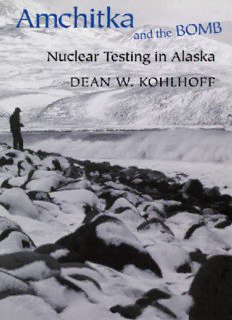
Amchitka and the Bomb: Nuclear Testing in Alaska PDF
Preview Amchitka and the Bomb: Nuclear Testing in Alaska
AMCHITKA AND THE BOMB AMCHITKA AND THE BOMB Nuclear Testing in Alaska DEAN W. KOHLHOFF UNIVERSITY OF WASHINGTON PRESS Seattle and london Copyright © 2002 by the University of Washington Press Printed in the United States of America Designed by Pamela Canell All rights reserved. No part of this publication may be reproduced or transmitted in any form or by any means, electronic or mechanical, Including photocopy, recording, or any information storage or retrieval system, without permission in writing from the publisher. Library of Congress Cataloging-in-Publication Data Kohlhoff, Dean. Amchitka and the bomb: nuclear testing in Alaska I Dean W. Kohlhoff. p.cm. Includes index. ISBN 0-295-98255-1 (alk. paper) 1. Nuclear weapons--Testing-Alaska-Amchitka Island. 2. Nuclear weapons-Testing-Environmental aspeets--Alaska-Amchitka Island. 3. United States-Politics and government-1945-1989. 4. Amchitka Island (Alaska)-History-20th century. 1. Title. u264.3 .K64 2002 363.17'99'09798221 2002066513 The paper used in this publication is acid-free and recycled from 10 percent post-consumer and at least 50 percent pre-consumer waste. It meets the minimum requirements of American National Standard for Information Sciences-Permanence of Paper for Printed Library Materials, AN S I Z39.48-1984. e 0 CONTENTS Foreword vii Preface IX 1 I Among the Many Islands 3 21 On an Anvil of War 13 3 I Before a Mighty Wmdstorin 26 4 1 Nuclear Alaska 40 5 I Under Rufus & Larkspur Scrutiny 48 6 1 During a Long Shot 55 7 1 Through Milrow Calibration 68 8 I For Safeguard Security 89 9 I Amid More Cannikin Controversy 98 10 1 Beyond the Last Bomb 109 Notes u8 Index 157 v FOREWORD D ean Kohlhoff died on June 12, 1997, before he had a chance to com plete final revisions on his manuscript for Amchitka and the Bomb. Be cause we knew that Dean's greatest unfulfilled wish was to have his story of the environmental consequences of nuclear testing on Amchitka Island told, Nancy Kohlhoff, Dean's widow, and I decided to take up the work of preparing his early draft for publication. In so doing, we hope that we have been faithful to Dean's goal of representing the struggle between the parti sans of national security and the defenders of the Aleutian environment as fairly. as possible. Dean's interest in the Aleutians was never simply acade mic. He always saw himself as advocate and defender of the Aleutians and its Aleut people. MEREDITH WM. BERG Valparaiso University Valparaiso, Indiana Dean worked on this manuscript until only a few days before he passed away. On one occasion, he said to me, "They won't publish my manuscript posthu mously, will they?" From then on,. I felt that if I could arrange to have the manuscript published, it would be the last, best thing I could do for Dean. Now, his work is finally complete. NANCY L. KOHLHOFF Valparaiso, Indiana vii PREFACE I n the 19608 and early 1970S, three underground nuclear tests were carried out on Amchitka Island, a small island in the Aleutian Chain. Each blast had its own name-Long Shot, Milrow, and Cannikin-but the name Am chitka became a code word for all of them. Although these tests were the only ones conducted on Alaska soil, there was a new alchemy at work. The tests linked island to bomb and North Pacific to Central Pacific. Amchitka, like Bikini and Eniwetok, became a byword in a new atomic age. Much controversy surrounded the tests primarily because the island lay in a national wildlife refuge. But other issues besides the ecological ones emerged. Amchitka's geology is prone to earthquakes and tsunamis. If these natural catastrophes could result from the blasts, people far away would be affected. The tests also were framed in the context of the nuclear arms race. Some officials believed the tests were essential to United States security in the face of the Cold War even though they maintained a measure of sym pathy for Amchitka's environment. The debate drew many opinions, in cluding those of politicians, scientists, and policy-makers. In the end, the Supreme Court decided for the largest and last test. My perspective on Amchitka has been shaped by several experiences. Even before I imagined a study like this, I taught courses on the history of American environmentalism. While traveling in Alaska, I met students whose political consciousness was expressed in protest against the bomb and for the safeguarding of the island. After I picked up this topic in 1992, I listened to interviews in which participants expressed a high level of emo tional commitment to Amchitka. Then, in the summer of 1994, I under stood why. On a research visit to Adak Island, I experienced the Aleutians for the ix
Description: